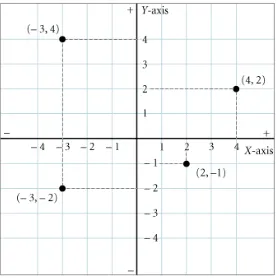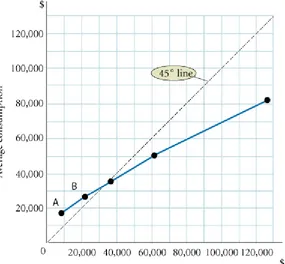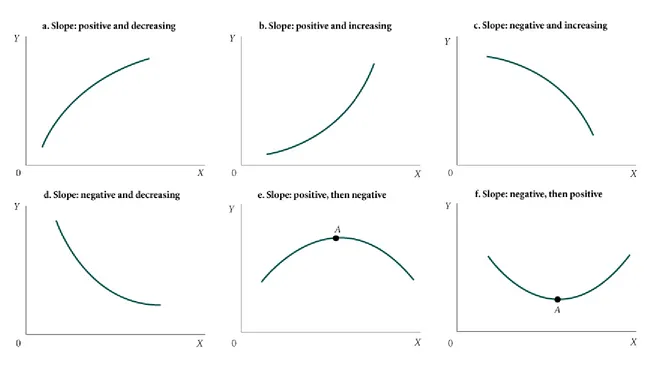Prepared by:
Fernando & Yvonn
Quijano
1
Chapter
PART I INTRODUCTION TO ECONOMICS
CHA
PTE
R
1:
The
Scop
e
an
d
Met
ho
d
of
E
cono
mi
cs
Chapter Outline
1
The Scope and Method
of Economics
PART I INTRODUCTION TO ECONOMICS
Why Study Economics?
To Learn a Way of Thinking To Understand Society To Understand Global Affairs To Be an Informed Voter
The Scope of Economics
Microeconomics and Macroeconomics
The Diverse Fields of Economics
The Method of Economics
Theories and Models Economic Policy
An Invitation
CHA
PTE
R
1:
The
Scop
e
an
d
Met
ho
d
of
E
cono
mi
cs
THE SCOPE AND METHOD OF ECONOMICS
economics
The study of how
individuals and societies choose to
use the scarce resources that
nature and previous generations
have provided.
CHA
PTE
R
1:
The
Scop
e
an
d
Met
ho
d
of
E
cono
mi
cs
There are four main reasons to study
economics:
•
to learn a way of thinking,
•
to understand society,
•
to understand global affairs, and
CHA
PTE
R
1:
The
Scop
e
an
d
Met
ho
d
of
E
cono
mi
cs
Three fundamental concepts:
Opportunity cost
Marginalism
, and
Efficient markets
TO LEARN A WAY OF THINKING
CHA
PTE
R
1:
The
Scop
e
an
d
Met
ho
d
of
E
cono
mi
cs
opportunity cost
The best
alternative that we forgo, or give
up, when we make a choice or a
decision.
scarce
Limited.
WHY STUDY ECONOMICS?
CHA
PTE
R
1:
The
Scop
e
an
d
Met
ho
d
of
E
cono
mi
cs
WHY STUDY ECONOMICS?
efficient market
A market
in which profit opportunities are
eliminated almost instantaneously.
Efficient Markets
—
No Free Lunch
CHA
PTE
R
1:
The
Scop
e
an
d
Met
ho
d
of
E
cono
mi
cs
WHY STUDY ECONOMICS?
Industrial Revolution
The
period in England during the late
eighteenth and early nineteenth
centuries in which new
manufacturing technologies and
improved transportation gave rise
to the modern factory system and
a massive movement of the
population from the countryside
to the cities.
TO UNDERSTAND SOCIETY
CHA
PTE
R
1:
The
Scop
e
an
d
Met
ho
d
of
E
cono
mi
cs
WHY STUDY ECONOMICS?
TO UNDERSTAND GLOBAL AFFAIRS
An understanding of economics is essential to an understanding of global affairs.
CHA
PTE
R
1:
The
Scop
e
an
d
Met
ho
d
of
E
cono
mi
cs
WHY STUDY ECONOMICS?
TO BE AN INFORMED VOTER
When we participate in the political process, we are voting on issues that require a
basic understanding of economics.
A knowledge of economics is
CHA
PTE
R
1:
The
Scop
e
an
d
Met
ho
d
of
E
cono
mi
cs
microeconomics
The branch of economics
that examines the functioning of individual
industries and the behavior of individual
decision-making units
—
that is, business firms
and households.
THE SCOPE OF ECONOMICS
MICROECONOMICS AND MACROECONOMICS
macroeconomics
The branch of economics
that examines the economic behavior of
aggregates
—
income, employment, output,
and so on
—
on a national scale.
Microeconomics looks at the individual unit
—
the household, the firm, the industry. It
CHA
THE SCOPE OF ECONOMICS
THE DIVERSE FIELDS OF ECONOMICS
TABLE 1.1
Examples of Microeconomic and Macroeconomic Concerns
DIVISION OF
ECONOMICS PRODUCTION PRICES INCOME EMPLOYMENT
Microeconomics Production/output in individual industries and businesses
How much steel How much office space
How many cars
Price of individual goods and services
Price of medical care Price of gasoline Food prices Apartment rents
Distribution of income and
Employment by
individual businesses and industries
Jobs in the steel industry
Number of employees in a firm
Number of accountants
Macroeconomics National
production/output
Total industrial output Gross domestic product
Growth of output
Aggregate price level
Consumer prices Producer prices Rate of inflation
National income
Total wages and salaries
Total corporate profits
Employment and unemployment in the economy
CHA
PTE
R
1:
The
Scop
e
an
d
Met
ho
d
of
E
cono
mi
cs
THE METHOD OF ECONOMICS
positive economics
An approach to
economics that seeks to understand
behavior and the operation of systems
without making judgments. It describes
what exists and how it works.
CHA
PTE
R
1:
The
Scop
e
an
d
Met
ho
d
of
E
cono
mi
cs
THE METHOD OF ECONOMICS
descriptive economics
The
compilation of data that describe
phenomena and facts.
Descriptive Economics and Economic Theory
economic theory
A statement or set of
related statements about cause and
CHA
PTE
R
1:
The
Scop
e
an
d
Met
ho
d
of
E
cono
mi
cs
THE METHOD OF ECONOMICS
model
A formal statement of a theory,
usually a mathematical statement of a
presumed relationship between two or
more variables.
variable
A measure that can change
from time to time or from observation to
observation.
CHA
PTE
R
1:
The
Scop
e
an
d
Met
ho
d
of
E
cono
mi
cs
THE METHOD OF ECONOMICS
ceteris paribus
,
or
all else equal
A
device used to analyze the relationship
between two variables while the values
of other variables are held unchanged.
All Else Equal:
Ceteris Paribus
Using the device of ceteris paribus is one part of the process of abstraction. In formulating
economic theory, the concept helps us simplify reality to focus on the relationships
CHA
PTE
R
1:
The
Scop
e
an
d
Met
ho
d
of
E
cono
mi
cs
THE METHOD OF ECONOMICS
The most common method of expressing
the quantitative relationship between two
variables is graphing that relationship on
a two-dimensional plane.
CHA
PTE
R
1:
The
Scop
e
an
d
Met
ho
d
of
E
cono
mi
cs
THE METHOD OF ECONOMICS
empirical economics
The
collection and use of data to test
economic theories.
CHA
PTE
R
1:
The
Scop
e
an
d
Met
ho
d
of
E
cono
mi
cs
THE METHOD OF ECONOMICS
ECONOMIC POLICY
Criteria for judging economic outcomes:
1. Efficiency
2. Equity
3. Growth
CHA
PTE
R
1:
The
Scop
e
an
d
Met
ho
d
of
E
cono
mi
cs
THE METHOD OF ECONOMICS
efficiency
In economics,
allocative efficiency. An efficient
economy is one that produces
what people want at the least
possible cost.
Efficiency
equity
Fairness.
CHA
PTE
R
1:
The
Scop
e
an
d
Met
ho
d
of
E
cono
mi
cs
THE METHOD OF ECONOMICS
economic growth
An increase in
the total output of an economy.
Growth
stability
A condition in which
national output is growing steadily,
with low inflation and full
employment of resources.
CHA
PTE
R
1:
The
Scop
e
an
d
Met
ho
d
of
E
cono
mi
cs
AN INVITATION
As you proceed, it is important that you
keep track of what you have learned in
earlier chapters. This book has a plan;
it proceeds step by step, each section
building on the last. It would be a good
idea to read each chapter’s table of
CHA
PTE
R
1:
The
Scop
e
an
d
Met
ho
d
of
E
cono
mi
cs
Review Terms and Concepts
ceteris paribus
descriptive economics
economic growth
economic theory
economics
efficiency
efficient market
empirical economics
equity
fallacy of composition
Industrial Revolution
macroeconomics
marginalism
microeconomics
model
normative economics
Ockham’s razor
opportunity cost
positive economics
post hoc, ergo propter hoc
scarce
stability
sunk costs
CHA
PTE
R
1:
The
Scop
e
an
d
Met
ho
d
of
E
cono
mi
cs
A
graph
is a
two-dimensional
representation of a
set of numbers, or
data.
HOW TO READ AND UNDERSTAND GRAPHS
CHA
PTE
R
1:
The
Scop
e
an
d
Met
ho
d
of
E
cono
mi
cs
Appendix
A
time series graph
shows how a single
variable changes over
time.
TIME SERIES GRAPH
CHA
PTE
R
1:
The
Scop
e
an
d
Met
ho
d
of
E
cono
mi
cs
GRAPHING TWO VARIABLES ON A CARTESIAN
COORDINATE SYSTEM
Appendix
The Cartesian coordinate
system is the most
common method of
graphing two variables.
This system is constructed
by simply drawing two
perpendicular lines: a
horizontal line, or X-axis,
and a vertical line, or
Y-axis. The axes contain
measurement scales that
intersect at 0 (zero). This
CHA
PLOTTING INCOME AND CONSUMPTION DATA
FOR HOUSEHOLDS
Appendix
TABLE 1A.1
Total Disposable Personal Income in the United
States, 1975
–
2005 (in billions of dollars)
YEAR TOTAL DISPOSABLE PERSONAL INCOME
YEAR TOTAL DISPOSABLE PERSONAL INCOME
CHA
PTE
R
1:
The
Scop
e
an
d
Met
ho
d
of
E
cono
mi
cs
Appendix
This line slopes upward, indicating that
there seems to be a
positive
relationship
between income and
spending.
Points A and B, above the 45 line,
show that consumption can be greater
than income.
TABLE 1A.2
Consumption Expenditures
and Income, 2003
AVERAGE INCOME BEFORE TAXES
AVERAGE CONSUMPTION EXPENDITURES
Bottom fifth 2nd fifth 3rd fifth 4th fifth Top fifth
$ 8,201 21,478 37,542 61,132 127,146
$ 18,492 26,729 36,213 50,468 81,731






